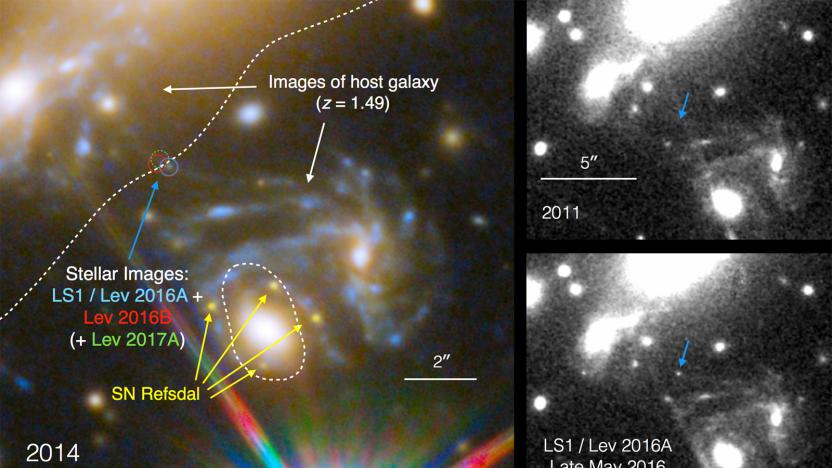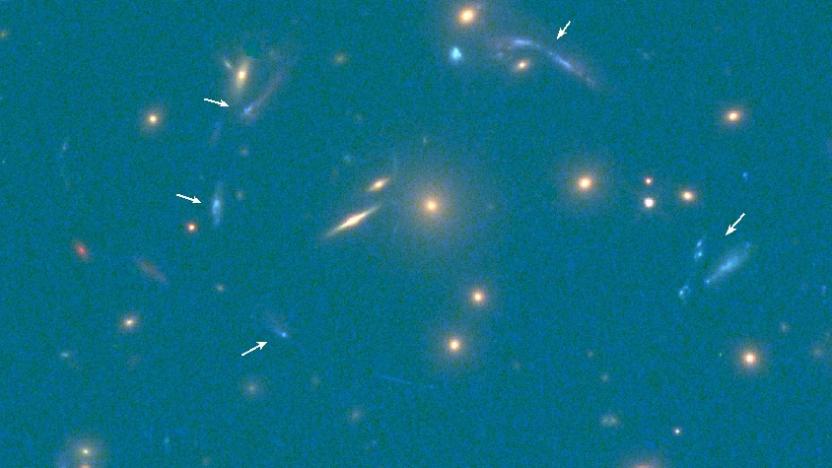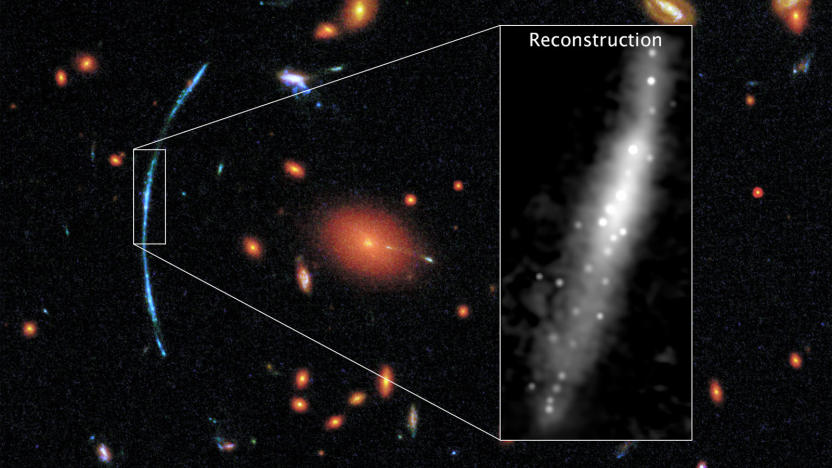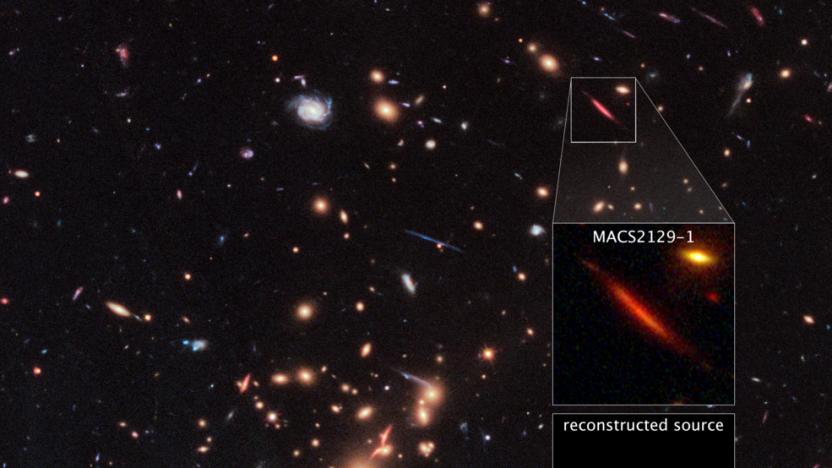gravitationallensing
Latest

Scientists validate theory of relativity on galactic level
Einstein's theory of general relativity is rather important when it's crucial to the modern understandings of the universe and technology like satellites. But does it hold up with something as vast as a galaxy? Thanks to researchers, we know the answer is "yes." They've conducted a test that used two comparatively distant galaxies, one in front of the other, to show that relativity checks out.

Hubble space telescope spots the farthest known star
Astronomers have spotted numerous extremely distant galaxies, but spotting individual stars is understandably much more difficult unless they go supernova. Sometimes, though, cosmic alignment works in their favor. Researchers using Hubble space telescope data have spotted Icarus (aka MACS J1149+2223 Lensed Star 1), a blue supergiant whose light was emitted when it was 9 billion light years away from Earth -- over 100 times farther than the previous record-setter. They captured the star thanks to a rare, ideal gravitational lensing effect where the star's light was magnified not only by the gravity of an in-between galaxy cluster 5 billion light years from Earth, but by a star inside that cluster. All told, the lensing magnified Icarus 2,000 times.

Astronomers use AI to reduce analysis time from months to seconds
Gravitational lensing is when the image of a distant object in space -- like a galaxy, for example -- is distorted and multiplied by the gravity of a massive object, such as a galaxy cluster, lying in front of the smaller, faraway object. It's a useful phenomenon that has helped scientists discover exoplanets, understand galaxy evolution, spot a super bright galaxy, detect black holes and prove Einstein right. But analyzing images affected by gravitational lensing takes a really long time, requiring researchers to compare real images with simulated ones. Just one lensing effect can take weeks or months to analyze.

Researchers discover one of the brightest galaxies ever seen
Scientists at the Instituto de Astrofisica de Canarias, a research institute in the Canary Islands, just discovered one of the brightest galaxies we've ever come across. It's around a thousand times brighter than our galaxy, has a very high rate of star formation and is 10 thousand million light years away.

Early universe 'fireworks' challenge notions of how stars form
At the rate things are going, astronomers may have to toss out the rule book for galaxy formation. Researchers using the Hubble Space Telescope have discovered an ancient galaxy (formed 2.7 billion years after the Big Bang) with two dozen star nurseries measuring 'just' 200 to 300 light years across. That sounds big, but scientists had expected that early universe star-forming regions had to be enormous, at 3,000 light years across or larger. Here, they're so tightly packed together that NASA researcher Jane Rigby likens them to "fireworks" popping off at a cosmic scale.

Current theories might be wrong about how a galaxy evolves
With the help of NASA's Hubble Space Telescope, researchers made a surprising discovery that goes against what we thought we knew about old galaxies and how they evolve. Our galaxy, the Milky Way, is a disk-shaped spiral galaxy. Typical of this shape of galaxy, the Milky Way's stars move around with predictable regularity and new stars are being formed throughout. From astronomers' observations, older galaxies that have stopped producing stars take on an elliptical shape with star motions that are unpredictable, different from the Milky Way and other younger galaxies.

NASA plans to make a telescope out of the Sun
As NASA astronomers peer further and further into space, they require ever larger and more powerful telescopes to do so. That's why one team of researchers from the Jet Propulsion Lab have proposed using the biggest object in our solar system, the Sun, as a cosmic magnifying glass.

Faintest known galaxy could shed light on the early universe
Scientists have only just started finding extremely faint galaxies. However, they've already topped themselves by discovering the faintest known galaxy to date... and it might just provide insight into the universe's early days. Found through gravitational lensing, the galaxy is both supremely ancient (13 billion years old) and extremely tiny (just 0.0001 percent the size of the Milky Way). In other words, it's a textbook example of the dwarf galaxies that researchers believe were key to re-ionizing the universe and taking it out of the lightless "dark ages." With enough study, it could help explain what triggered that ionization and fill in one of the gaps in our understanding of existence.

NASA's resurrected telescope seeks wandering planets
NASA is kicking off a search for free-spirited exoplanets as part of the Kepler space telescope's extended K2 mission. It's an impressive quest for an instrument that was all but written off several years ago because of damage to its control wheels. NASA managed to stabilize the device using radiation pressure from the sun and it's been spotting exoplanets, stars and galaxies ever since. Now, the space agency wants to use the device to survey millions of stars in the Milky Way galaxy looking for signs of "wandering" exoplanets with no companion star.

Here's your clearest view yet of star formation in the early universe
Spotting anything at the edge of the known universe is difficult, but scientists have just managed to get a surprisingly sharp view. They've used the ALMA telescope array's imaging and spectral info to visualize a galaxy about 11.4 billion light years away (2.4 billion years after the Big Bang) in unprecedented detail -- enough to see clumps of stars that were still forming at the time. The key was taking advantage of a special gravitational lensing effect, an Einstein ring, where Earth is in perfect alignment with both the target galaxy and an in-between galaxy distorting and magnifying the target's light. Researchers used modeling to correct for that distortion and see what the ancient celestial body really looked like. It's not a perfect picture (the intermediary galaxy's black hole is obscuring things), but it's still humanity's best peek yet at what was happening well before our planet even existed. [Image credit: ALMA (NRAO/ESO/NAOJ)/Y. Tamura (The University of Tokyo)/Mark Swinbank (Durham University)]

The Big Picture: A far-away supernova split into four
Gravity can play a lot of tricks with light, and we're not just talking about black holes. Take this recent Hubble Space Telescope discovery from UC Berkeley's Patrick Kelly, for example: those four lights are actually a distant supernova magnified and split into four images by the gravitational lensing of a giant galaxy. Besides looking cool, the image promises to be a gold mine for astrophysics. The time delay between those four lights will let researchers study both the properties of the exploding star and the galaxy, including the presence of dark matter. The best part? Due to the light's unusual path, there's a good chance that scientists will get a "rerun" in a few years if they want to see it again. [Image credit: NASA/ESA/FrontierSN/GLASS/Frontier Fields]



